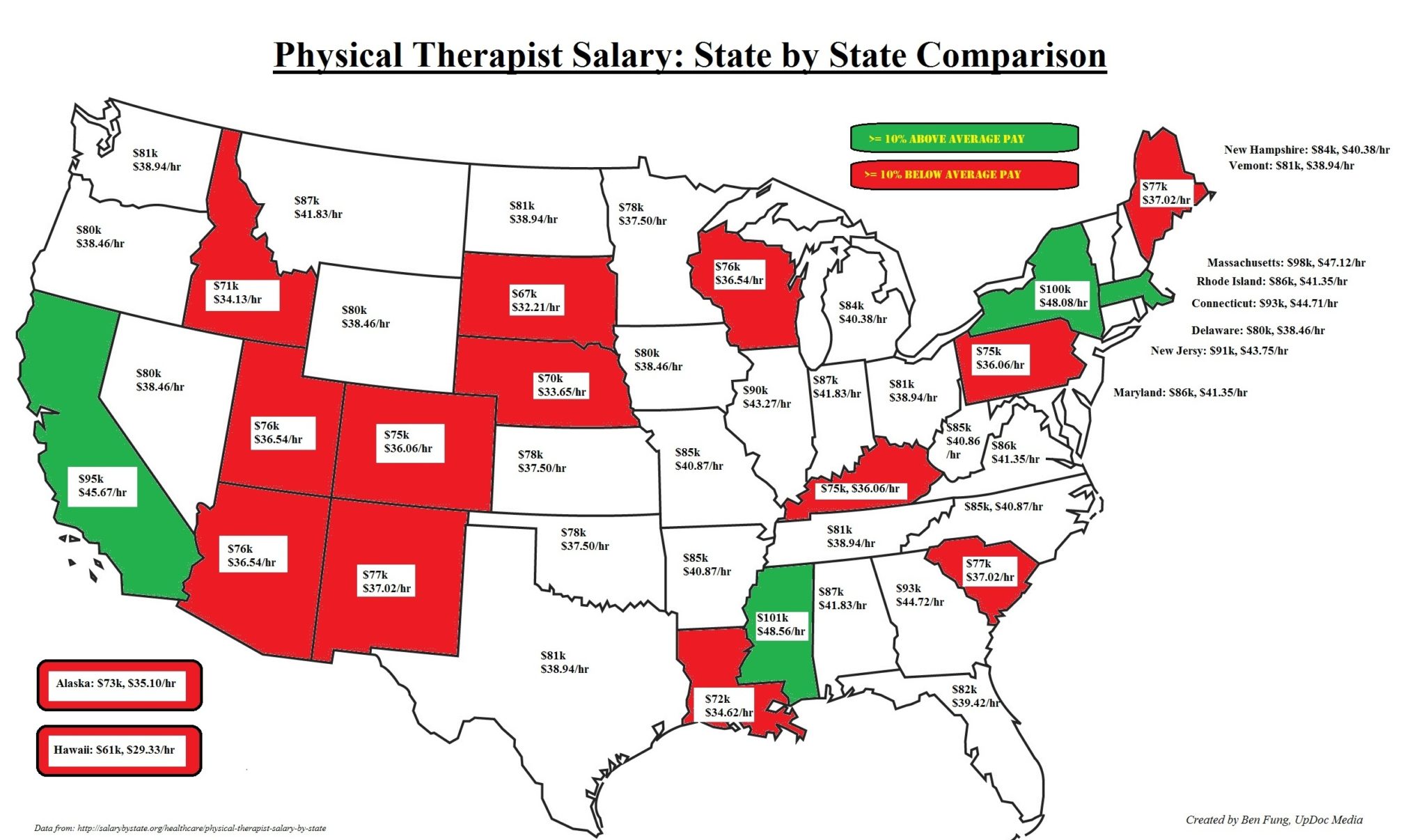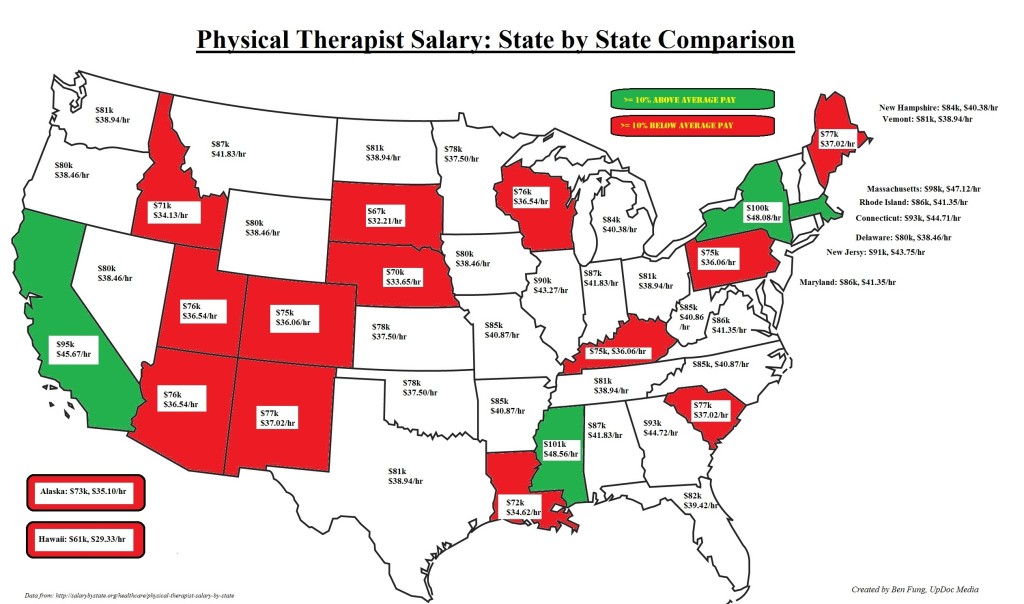
The 2015 Physical Therapy Job Market Outlook (Version 2.0)
Wage transparency and equitability is a big force in play for our millennial job market. Compensation packages are getting more and more diverse and it can be difficult to know if you’re getting a fair wage. Let’s start with the data out there.
From a cursory glance, you must be thinking the same thing I was when I took a look at the numbers. They look really high. Now depending on where you look, be it the Department of Labor, Monster, Indeed, Glassdoor, etc. Each of these databases pre-process the data before they give it to you. The data I used to put this infographic together has a few areas of concern which need explanation. However, it also gives us some powerful frames of reference for the new grad entering the scene.
From what I found out, these numbers are quite a bit higher than those that the APTA has published in the past, and, they are more impressive than that of the Department of Labor. Doing some quick math, what we’re looking at is likely the result of one of two things.
First, this could be representative of the total value of the compensation packages in each given state. Secondly, we could be looking at pay by equal volume. Meaning, the data represented includes a slight bias for all the PTs who have been in the business for quite some time. After so many years, their compensation packages have inflated upwards of 30% more pay after 10 years to sometimes up to 75% after 20 years. Sadly, the rules have changed for those of us coming into the job market as the top-end of pay grades are starting to have shallow ceilings. Finally, the pay represented here may have failed to take into account population frequencies amongst PT pay grades. Therefore, those PTs working in SNFs and home health agencies have a stronger representation of pay than that of outpatient settings.
In all cases, the information here is actually VERY useful for new grads and fresh PTs who are only in their first, second, or third year in the job market. Considering that full time pay really constitutes a compensation package of your pay grade/rate, your benefits, your perks (fringe benefits), the mentorship program, the CEU reimbursement, the tuition assistance program, the opportunity, the upward mobility, the brand name association, and even exposure, we have a lot to consider when it comes to accepting, rejecting, or counter-offering a job.
Now, before we get straight into the numbers, I want you to know that the numbers I list below are primarily from the perspective of someone in the Southern California job market. I’ve widened the ranges so it’s applicable nationwide. However, what you can do to make your number more relevant is by contrasting it against the numbers on the infographic.
- If you feel the average PT in your area is a 10 year veteran, multiply the number in your state by 85% for the upper bound and 70% for the lower bound to what entry level is likely to pay.
- So as an example, the stated mean compensation of California is $45.67/hr. $45.67 * 0.7 = roughly $32/hr, which is an accurate representation of the market here in Southern California for outpatient physical therapy pay grades.
- If you feel the average PT in your area is a 15-20 year veteran, then multiply the number in your state by 70% for the upper bound and 60% for the lower bound.
- Now, I just want to caution you, these percentages are a function of the assumption that the market has considered annual raises and inflation adjustments. I would suggest you use the 10 year veteran mathematics into more relevant consideration since those numbers are likely more accurate. Comparing yourself against the sustained raise of someone who has been in the same job for 20 years is a scary thing, not to mention less relevant and realistic.
Now, let’s talk about the elements of compensation package!
- The Pay
The pay for new grads will obviously be lower than the mean. However, it does not mean it has to be that way. I can tell you for a fact, as a rehab director, I’ve hired new grads at per hour rates equitable for their skill and performance which also deemed as the “average pay” in my region. It is possible!
For Physical Therapy, there are 4 major segments where pay is severely different for operating reasons. They are:
- Outpatient
- New grad PT ranges from $27-35 per hour.
- New grad PTA ranges from $20-25 per hour.
- On a regional level, the suburbs pay the best followed by urban then rural.
- On a principles level, outpatient makes 15-25% less than in SNFs.
- Acute Care Hospital
- New grad PT ranges from $30-37 per hour.
- New grad PTA ranges from $22-27 per hour.
- The same regional & principle variations exist. However, do note that since hospitals must staff for all 7 days of the week, you may get a little bump in your pay if you negotiate with flexible scheduling to fill weekend needs.
- Skilled Nursing, Long Term, & Acute Rehab
- New grad PT ranges from $38-45 per hour.
- New grad PTA ranges from $27-33 per hour.
- Generally, PTs make $10/hr more than PTAs for this setting. Also, you can easily get a 5-15% raise from negotiating weekend scheduling. It can easily be $2-3/hr extra which translates to several thousand more dollars a year!
- Home Health
- This is the most variable in pay, per agency and per region.
- Many companies do not pay by the hour; rather, they pay by the service. In essence, you keep a piece of the pie for the work you do. As such, I’ll translate out a full time equivalent which again, is highly variable.
- Example: For a treatment, a PT can earn $60. For an OASIS start of care, they can earn $180. Again, it’s not time dependent, but dependent on the completion of service.
- New grad PT ranges from $40-50 per hour or ~$100,000 if productivity is met.
- New grad PTA ranges from $30-40 per hour or ~$80,000 if productivity is met.
- The Benefits
Health Benefits
Health benefits are typically one of three kinds. A classic HMO, a PPO, or a high deductible PPO with an HRA or FSA account. Typically, working for health systems like a hospital base or medical group based company will yield an HMO. The same types of firms will also offer a PPO which means you pay a lot out of pocket until you reach a magic number.
A lot of companies are going lean and are headed towards the High Deductible Health Plan (HDHP). This is excellent for very healthy individuals with no history (including family) who have a low risk lifestyle. The HRA and FSA accounts also offer some tax benefits but may require more calculation; sometimes this means you end up putting money away you never get back or get to use.
Retirement
Most companies offer a 401k while some offer a 403b. Regardless, you don’t really get a choice. The retirement plan is the plan and the company has made a contract with their wealth management company to provide options in a very specific way. The key is when these plan kick in and how much of it is matched. Companies that tend to pay less tend to match more; it’s not uncommon for companies that pay poorly to match 5-8%. Should you be offered defined benefits, this may account for over $10k of retirement funds added to your account every year! In contrast, firms that pay handsomely match none the first year, 1% the 2nd year, 2% the 3rd year, and finally 3% the 4th year of your loyalty to the company. Worth it? Well. it’s free money, right?
Adjunct Insurance
To me, this isn’t really important to the new grad. Honestly, there are better options via life insurance agents. In any case, the same deal occurs here. The plan is the plan; you can’t really change it or negotiate for it. For the most part, this is just a way for any given firm to be more competitive compared to the next in hopes of retaining or attracting the best talent. This is also a way for a company to protect itself from too much work comp and/or litigious complications. “Hey, we offered… you got disabled on your own.” #ClassyOfThem
CEU Reimbursement & Tuition Programs
Some companies will offer unlimited CEUs while others only give a percentage of a couple hundred to a couple thousand dollars worth until you reach a certain level of seniority. Again, the same idea for retirement funds run here — the better they pay, the less likely they will pay for your education. On the level, most corporations will give you $1000 as a good baseline. $2000 if they don’t pay you all that well. If they run percentages, you get 50% of each bill reimbursed the 1st year of loyalty, 75% the 2nd, and finally 100% of all CEU costs the 3rd and going forward.
BEWARE!
Many companies require you work one or two FULL CALENDAR months before benefits kick in. Be VERY clear about this because you may work on the first Monday of a month. However, because that date is say… March the 2nd… you will not get benefits until MAY!!! So, be crystal clear about when benefits kick in and WHY.
- The Opportunity
So, this is where I’m going to talk about balance. Every compensation package has 6 dimensions:
- Pay
- Benefits
- Fringe (aka “Perks)
- Balance (work-life-balance)
- Culture
- And, Opportunity
They are grouped in triplets; Pay, Benefits, Fringe -vs- Balance, Culture, and Opportunity. As such, there is an overall value of compensation any business can give. And, in healthcare, particularly in PT, there is certainly a limit to how much we can physically earn and get paid for. As such, the higher the pay, the lower the benefits and fringe. The higher the benefits, the lower the pay and fringe. The same exists for balance, culture, and opportunity. For a new grad, opportunity is very important.
The opportunity for new grad who wish to climb the administrative ladder need to pay attention to culture and balance upon interviewing/hiring in. Poor balance leads to stressed out employees and a sad culture (ie. low moral, backstabbing, grumpy people you have to work with). This environment leads to lots of turnover, and therefore, the opportunity to move up and get that promotion. HOWEVER, you’re not immune after the fact. You’ll likely burn out just as quickly as your former boss just did. Nevertheless, it is something of interest in getting that early promotion so you can transfer laterally to a more favorable situation.
So, that is all for Part 1! I know that after all of this information, one thing still stands out. The pay! Why is the pay so different??? Well, the other aspect is that the market tends to cause for wage adjustments every 5-10 years due to people entering and exiting the job market (ie. graduation or retirement). No matter the case, if you’re being offered something far lower than you see on the infographic, even when adjusted for new grad rates by multiplying by say 70% or so… what is happening is you’re getting low balled. You’ve got to negotiate and counter offer!
We’ll be talking about that and more as I’m putting together this Version 2.0 outlook in a five part series especially for the New Grad or almost New Grad Physical Therapist!
Stay tuned!











